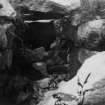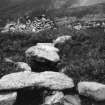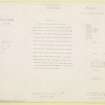Pricing Change
New pricing for orders of material from this site will come into place shortly. Charges for supply of digital images, digitisation on demand, prints and licensing will be altered.
Upcoming Maintenance
Please be advised that this website will undergo scheduled maintenance on the following dates:
Thursday, 9 January: 11:00 AM - 3:00 PM
Thursday, 23 January: 11:00 AM - 3:00 PM
Thursday, 30 January: 11:00 AM - 3:00 PM
During these times, some functionality such as image purchasing may be temporarily unavailable. We apologise for any inconvenience this may cause.
Field Visit
Date 22 July 1924
Event ID 1103325
Category Recording
Type Field Visit
Permalink http://canmore.org.uk/event/1103325
Earth-house, St Kilda.
At the western end of the village of St Kilda the ground rises slightly towards the north, and, at a spot about 100 yards north-west of the township, in close proximity to the present burial ground, an earth-house was accidentally discovered about 1844, and opened and examined in 1876 (1). The internal passage, which measures about 34 feet in length by approximately 4 feet in height and 3 ½ feet broad, is roughly lined with stones of various sizes, apparently unworked. There is one side chamber 6 ft. 2 ins. long and evidence of two others. Here and there undressed roofing slabs of about 8 inches in thickness remain in situ. When disclosed in 1876 the floor was found to be of flat stones with a drain below. It was covered with peat ash and soot in a layer about a foot thick, in which were found bones of animals and sea-fowl, burnt limpet shells, “a large number of rude stone implements resembling hatchets and wedges”, “part of a lamp”, and some fragments of coarse pottery (2). (Figs. 74, 75.)
RCAHMS 1928, visited (by Captain Patrick Grant) 22 July 1924.
(1) See Proc. Soc. Ant. Scot., XII., pp. 186-7; cf. also VII., p. 172.
(2) Mr Sands, who had the place opened in 1876, writes: “The men told me that they had often found small vessels of clay in the earth, but had never seen any pottery made, nor heard that it had ever been made in Hirta. Stone lamps are still to be seen above ground, and some old men told me they had often used them when in Berneray and Soa. It is remarkable that all to whom I showed the implements recognised them at a glance…ʻSean lamhog, sean sgian, old axe, old knife’, they said…It is probable that stone implements were used in St Kilda at a very recent date”. (As cited, p. 187.) Mr R. Kearton says the place “had been only partially explored and to a great extent destroyed”. Among other relics he found an iron spear-head (With Nature and a Camera (1897), p.13.













